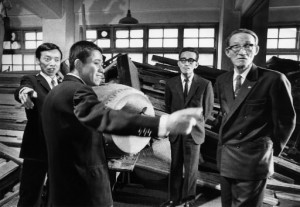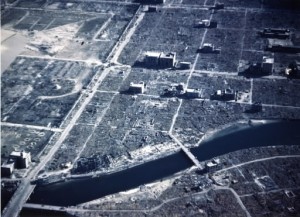Hiroshima: 70 Years After the A-bombing: Close-range Survivors 9
Aug. 27, 2014
Hitomi Ota (died in 2007) and Sadao Arashi (died in 1993): Miracle in basement
At Fukuromachi National School at time of A-bombing
Raised families, went on with their lives
The Peace Museum at Fukuromachi Elementary School in Hiroshima’s Naka Ward opened in 2002 in a portion of the west wing of what was then Fukuromachi National School. The ferroconcrete building, which survived the atomic bombing, is located approximately 460 meters from the hypocenter. The museum features a display titled “Miracle in the Basement” on the three students who survived the atomic bombing in the basement and their escape. They are identified only by the first letters of their last names: “A,” “O” and “T.”
Like Osaka resident Tsunehiro Tomoda, 78, who was featured in an article in this series on July 21, the other two survivors were orphaned. They met the hardships resulting from the A-bombing head on, raised families and went on with their lives.
Sent to orphanage after losing parents
Hitomi Ota died in 2007 at the age of 70. His wife, Sekiko, 72, was interviewed at her home in Asakita Ward, where she lives alone. “He had stomach cancer and suffered from lung cancer too at the end,” she said of her husband. They were married for 43 years.
On the morning of August 6, 1945, Mr. Ota, a second grader, came out into the schoolyard barefoot. His teacher told him to put some shoes on because the students were to clear away debris from the wooden schoolhouse, which had been torn down. In “History of Hiroshima,” a series of articles published by the Chugoku Shimbun in 1995, Mr. Ota described the moment of the atomic bombing: “I went down to the basement where the shoe cupboards were, got my shoes and was running up the stairs.”
The A-bombing took the lives of six of his family members: his father Satoru, 45; mother Kameno, 44; and four of his siblings. He parted from his elder brother and sister, who had returned from the countryside where they had gone to escape air raids, and was sent to live at the Hiroshima Prefectural War Orphans Foster Home (now Ninoshima Gakuen) on Ninoshima, an island in Hiroshima Bay.
In 1952, the year the Allied occupation of Japan ended, the Cenotaph for the A-bomb Victims was erected in Peace Memorial Park. It was unveiled by A-bomb orphans. Among them was Mr. Ota. He lived at the orphanage until he was in the third year of junior high school, when he went to live with his older brother, who was by then on his own. After graduating from high school Mr. Ota attended a photography school in Osaka.
He married in 1964. At the time he was running a photo-finishing shop in Ebisu-cho (now part of Naka Ward). Sekiko said he took her to his family temple in Tera-machi (Naka Ward) and simply said, “Here is my parents’ grave.” When the lease on his shop expired he started driving a taxi but found it tiring. At 34 he was employed by the city. After the couple had two sons, the family built a home in a housing development in Kabe-cho (now part of Asa Kita Ward).
His stomach cancer was found in 1991. His stomach was completely removed and he quit drinking alcohol, which he had enjoyed. In 1995 his elder son was killed in a traffic accident at the age of 29, and in 2004 his 10-year-old granddaughter died of leukemia. He wondered if it was his fault. Although the doctor said it was not, he became very depressed.
In the living room Sekiko looked at a photograph taken to mark her husband’s 70th birthday and recalled the occasion regretfully. “This was three months before he died. He had avoided talking about his childhood in the orphanage, but that day he spoke about it animatedly. I didn’t think he would die. I should have asked him more about it,” she said.
Apprenticeship at sushi shop
Sadao Arashi died of stomach cancer in 1993 at the age of 57.
Upon visiting the sushi shop in Matsue, Shimane Prefecture that Mr. Arashi had run, though perplexed, his 70-year-old widow spoke matter-of-factly over the counter. “He just regarded it as all in the past,” she said. “For the name of the shop to come up now in connection with the A-bombing…”
Mr. Arashi was a fourth grader at the time of the atomic bombing. He and Mr. Tomoda, who was his classmate, emerged from the basement and fled to Hijiyama. Mr. Arashi was taken in by his father’s younger sister, who lived in Matsue. His father had already died, and he was the only one in his family left after losing eight others in the A-bombing: his mother, grandparents and five siblings.
After graduating from junior high school, he went to live at a sushi shop and apprenticed there. He married in 1965 after having gone to work for a shop opened by his future wife’s father. The business did well enough for him to relocate to the shop’s current location near a tourist spot. He and his wife raised a son and a daughter.
“Whenever he’d see a TV program on the A-bombing he’d say, ‘That’s not what it was like,’” his wife said. Mr. Arashi never spoke seriously to his family about his experiences on the day of the A-bombing or the feelings he kept inside.
The sushi shop, which seats about 30 customers, is now run by Mr. Arashi’s 47-year-old son. Even when there were few customers, he continued silently making sushi. “It’s a hard job, but he took it over on account of his feelings for his father,” said Mr. Arashi’s wife, recalling her husband working behind the same counter where her son stood. It was the only time she smiled.
(Originally published on July 28, 2014)









